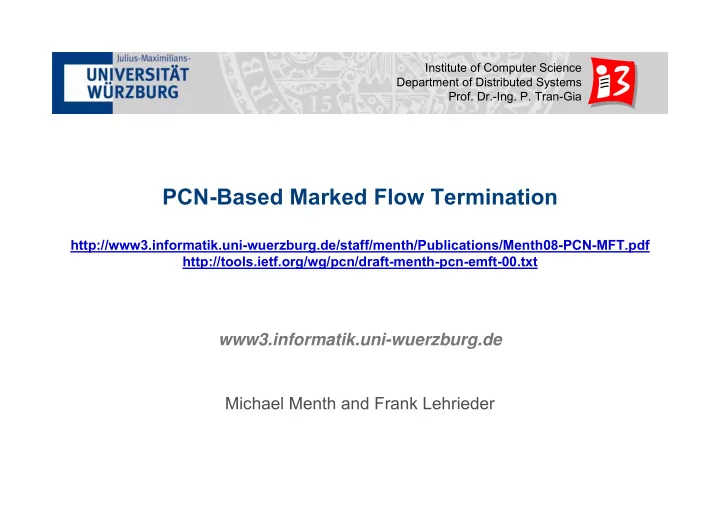

Institute of Computer Science Department of Distributed Systems Prof. Dr.-Ing. P. Tran-Gia PCN-Based Marked Flow Termination http://www3.informatik.uni-wuerzburg.de/staff/menth/Publications/Menth08-PCN-MFT.pdf http://tools.ietf.org/wg/pcn/draft-menth-pcn-emft-00.txt www3.informatik.uni-wuerzburg.de Michael Menth and Frank Lehrieder
Overview � Motivation � Mechanisms � Performance � Summary Termination Methods for 2 End-to-End PCN-Based Flow Control
Marked Flow Termination (MFT) � Terminates flows with marked packets � Gradual termination process � Copes well with ECMP � Problem: too aggressive � 2 solutions � Core-assisted MFT (CMFT, 3sm) – Marking frequency reduction in core nodes • Fewer packets get marked • Terminate any flow with marked packets � Edge-assisted MFT (EMFT) – Egress nodes terminate only some marked flows Termination Methods for 3 End-to-End PCN-Based Flow Control
Edge-Assisted MFT (EMFT) � Flow-based EMFT � Aggregate-based EMFT � Applicable for end-to-end � Applicable for PCN domain PCN � Credit counter per IEA � Credit counter per flow – Random initialization – Random initialization � Marked bytes reduce credits � Marked bytes reduce credits � Credit counter ≤ 0 � Credit counter ≤ 0 – Terminate one flow of the – Terminate flow IEA – Increase credit counter proportionally to rate of terminated flow Termination Methods for 4 End-to-End PCN-Based Flow Control
Experiment Setup � n independent traffic sources � Bottleneck link � Termination rate 100 flows � Overload 100% � No packet loss � Flow termination delay: D T =200ms B Multiplexer TB Marker CMFT n F-EMFT S A-EMFT R T Egress node performing FT A Termination Methods for 5 End-to-End PCN-Based Flow Control
Termination Aggressiveness α � CMFT: α controls marking frequency reduction in core � EMFT: α controls initialization and increments of credit counters � Termination speed increases with α � Overtermination avoided for α≤ 1 Termination Methods for 6 End-to-End PCN-Based Flow Control
Impact of Overload � Fast termination also for large overload � Packet loss not simulated Termination Methods for 7 End-to-End PCN-Based Flow Control
Differences of MFT Variants � All methods � Flow-based EMFT � Flow termination delay � Suitable for end-to-end PCN impacts termination speed � Termination priorities � No unfairness possible ( α =0.25, 1.0) � CMFT � Termination speed depends on packet frequency of flows � No termination priorities possible � Allows anti-cheating for end- to-end PCN � Aggregate-based EMFT � Suitable for PCN domains � Termination policies possible Termination Methods for 8 End-to-End PCN-Based Flow Control
Summary � Marked flow termination (MFT) � Core-assisted MFT � Edge-assisted MFT – Flow-based (end-to-end PCN) – Aggregate-based (PCN domain) � Simple edge behaviors � Termination behavior well understood � Aggressiveness α � Self-correcting mechanism � Invariant to many system parameters � What’s missing in the study: severe overload and packet loss Termination Methods for 9 End-to-End PCN-Based Flow Control
Recommend
More recommend